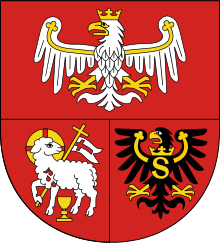Coat of arms of the Warmian–Masurian Voivodeship
| Coat of arms of the Warmian–Masurian Voivodeship | |
|---|---|
 | |
| Armiger | Warmian–Masurian Voivodeship |
| Shield | Red Iberian style escutcheon |
The coat of arms of the Warmian–Masurian Voivodeship, Poland consists of a red Iberian style escutcheon (shield) that is divided horizontally into two parts. The top part features a white eagle with a yellow (golden) crown on its head. The bottom part is divided vertically into two fields. The left bottom field depicting a Lamb of God, in a form of a white (silver) sheep with a yellow (golden) circular aureola behind its head, holding in its right hoof, a yellow (golden) cross with a white (silver) banner with red cross on it, attached to it, and bleeding from its chest, with the red drops of blood falling towards a yellow (golden) chalice placed in front of it, between its legs. The right bottom field depicts a black eagle with a yellow (golden) crown put on its neck, and a capital letter S placed on its chest.[1]
The coat of arms was designed by designed by Paweł Dudziński, and adopted in 2002.[2][3]
Design
[edit]The coat of arms of the Warmian–Masurian Voivodeship consists of a red Iberian style escutcheon (shield) with square top and rounded base, that is divided horizontally into two parts. The top part features a white (silver) eagle with long outstretched wings. It wears a yellow (golden) crown on its head, and has yellow (golden) beak, eye, and legs. On each of its wings, there is a yellow (golden) upwards-curved bar, stretched from its chest to the end of its wings, ended in a trefoil.[1] It is based on an eagle used as the symbol of Poland, during the rule of Władysław II Jagiełło, who was the king of Poland from 1386 to 1434.[4]
The bottom part of the coat of arms is divided vertically into two fields. The left field features the Lamb of God, in a form of a white (silver) sheep with a yellow (golden) circular aureola with a red cross within it, behind its head. In its front right hove, it holds a yellow (golden) cross with a white (silver) banner with red cross on it, attached to it. It bleeds from its chest, with the red drops of blood falling towards a yellow (golden) chalice placed in front of it, between its legs.[1] It is based on the coat of arms of the historical region of Warmia, more precisely the Prince-Bishopric of Warmia, and the Roman Catholic Archdiocese of Warmia, with the Lamb of God being one of the regional symbols since the 14th century.[5][6]
The right bottom field features a black eagle with risen wings, and its head turned to its right. It wears a yellow (golden) crown on its neck, and has a yellow (golden) beak and legs, and a white eye. On its chest it has a yellow (golden) capital letter S on its chest, which refers to Sigismund I the Old, king of Poland from 1506 to 1548. On each of its wings, there is a yellow (golden) upwards-curved bar, stretched from its chest to the end of its wings, ended in a trefoil. The eagle is based on the coat of arms of the Duchy of Prussia which existed from 1525 to 1657. King Sigismund I the Old had established said design in the 16th century.[1][7] It is sometimes attributed to the historical region of Masuria.
History
[edit]The coat of arms was designed by Paweł Dudziński, and adopted by the Warmian–Masurian Voivodeship on 6 August 2002.[2][3] Its design had been criticized by the Heraldic Commission of Poland, and was not approved by the Minister of Culture and National Heritage of Poland.[2]
See also
[edit]References
[edit]- ^ a b c d "Znaki i symbole regionu". warmia.mazury.pl (in Polish).
- ^ a b c Artur Wójcik. "Orzeł à rebours". jakiznaktwoj.pl (in Polish).
- ^ a b Uchwała Nr XXXIX/561/02 Sejmiku Województwa Warmińsko-Mazurskiego z dnia 6 sierpnia 2002 r. w sprawie ustanowienia herbu, flagi, pieczęci oraz odznaki radnego Województwa Warmińsko-Mazurskiego., Olsztyn: Warmian–Masurian Voivodeship Sejmik, 6 August 2002. In: 2002 Journal of Laws of the Warmian–Masurian Voivodeship, Olsztyn: Warmian–Masurian Voivodeship Sejmik, 2002.
- ^ "Herby Królów Polski". akromer.republika.pl (in Polish). Archived from the original on 2012-03-15.
- ^ Stanisław Achremczyk: Warmia, Olsztyn 2000.
- ^ Jan Chłosta: Słownik Warmii (historyczno-geograficzny), Olsztyn, 2002.
- ^ Christiane Brandt-Salloum (editor): Adlers Fittiche. Wandlungen eines Wappenvogels. Dokumentation einer Präsentation des Geheimen Staatsarchivs Preußischer Kulturbesitz, Duncker & Humblot, Berlin 2008, ISBN 978-3-428-12959-1.



